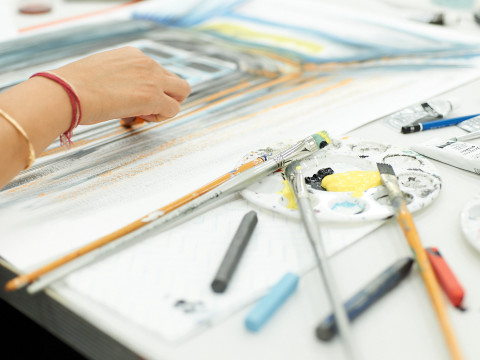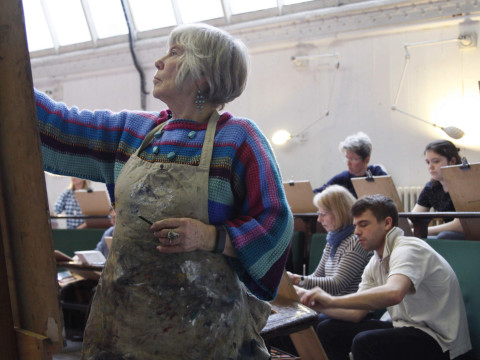
The art of collecting: individual and corporate collections
Weekend-long art business course
10 June 2017 10am - 5pm11 June 2017 10am - 5pm
General Assembly Room, Burlington House, Royal Academy of Arts, Piccadilly
£290 for one day / £540 for two days. Includes light lunch, refreshments and a drinks reception on both days.
Terms and conditions
Drawing on specialist knowledge of exceptional private and corporate collections, as well as practical expertise, Charlotte Appleyard, the Royal Academy’s Director of Development and author of 'Corporate Art Collections: A Handbook to Corporate Buying', will introduce in this course approaches to art collecting as well as practical tools and techniques that can enable a successful collection to stand the test of time.
Although made up of individual items, a successful collection has the potential to become greater than the sum of its parts. For individual, private, corporate and institutional collectors, understanding how to build and maintain a successful collection is not just a matter of luck, but relies on skills and strategy.
The practice of collecting has a long history that can be traced back thousands of years. In Europe, it is widely associated with the patronage of the church, state and crown from at least the Renaissance onwards. The systematic acquisition, trade and display of art, as well as luxury items and curiosities, found more widespread expression with the growth of the Dutch and Flemish markets in the 17th century. The articulation of collecting as a pastime, coupled with the rise of collectors, became established throughout the 18th and 19th centuries in Europe. By the 20th century, individual collectors clearly represented a driving force within specific artistic markets and movements. In the 21st century, corporate or institutional collections have become an increasingly common vehicle for the acquisition and exhibition of art.
Drawing on specialist knowledge of exceptional private and corporate collections, as well as practical expertise, Charlotte Appleyard, the Royal Academy’s Director of Development and author of Corporate Art Collections: A Handbook to Corporate Buying, will introduce in this course approaches to art collecting as well as practical tools and techniques that can enable a successful collection to stand the test of time.
Although made up of individual items, history has shown time and time again that a collection can become greater than the sum of its parts. However, the way in which a collection is best assembled and the techniques and strategies employed to maintain and increase its social and or economic value are rarely discussed and hotly contested. As well as the process by which a collection is put together, of importance is the way it can (or does not) acquire purpose and momentum – a meaning and identity of its own.
Although individual collections can undoubtedly be a source of great pleasure, they also have a profound role to play in the communication and preservation of culture and its values. Understanding how to build a collection therefore has not only practical and financial but also social significance.
This two day expert-led course including specialist guest speakers provides a practical overview of collecting. It covers techniques and approaches to collecting employed by art world experts – exploring how to build and maintain a collection. The course takes into account different types of collectors, collections and different motivations – including individual versus corporate or institutional approaches, each of which includes specific risks and opportunities, drivers and outcomes.
Day one of the course will introduce strategies and structures for building a private collection. The day’s discussions will draw on both expert-led experience, using specific case studies to enable participants to better understand how to source, design and build a collection for the short, medium and long-term. The examples and cases illustrate how great collections can be built even with modest means and small beginnings, and how the growth in the contemporary art market has created not only risks but also opportunities.
Day two focusses on strategies for corporate and institutional collectors and collections. This day will explore how and why organisations choose art collecting as a vehicle for investment as well as for other reasons. It will consider several leading corporate collections, their history, legacy, significance, and possibilities for building such collections. The day will provide practical guidance for why corporate collecting might make sense for commercial or charitable enterprises, and cover the benefits and risks of collecting within an institutional framework and from an organisational perspective.
Participants will discover and discuss strategies for building and maintaining an art collection, and share ideas of what to look for and what to avoid. The course will address the practice and purpose of collecting – both private and corporate – and why and how a successful collection can make an economic and financial contribution, but also social and cultural sense.
£290 for one day / £540 for two days. Includes light lunch, refreshments and a drinks reception on both days.
Terms and conditions

About this course
This course will be led by a course leader with contributions from guest speakers.
Course Leader
Charlotte Appleyard, Director of Development, Royal Academy of Arts
Charlotte Appleyard is Director of Development at the Royal Academy of Arts. She oversees all fundraising and partnership activity, including major donors, Friends, corporate sponsors and capital campaigns. She previously worked at Outset Contemporary Art Fund, and in the curatorial departments at The National Gallery in London and the Metropolitan Museum of Art in New York. In 2012 she published Corporate Art Collections: A Handbook, a history and survey of corporate collections. She is a trustee of the Institute of Contemporary Arts in London and a graduate of Oxford University, the Courtauld Institute and Harvard Business School.
This course is suitable for all levels.
This course is for you if:
• You would like to understand the process and practice of art collections and learn to apply the methods and techniques based on best practice
• You are interested to learn about strategies and structures of different types of art collectors and collections as well as a range of drivers and motivations.
• You seek to enhance your knowledge in the various art collecting approaches across different sectors of the art market
• You are interested to find out what role art collecting and collections play in the wider market and art world
• You would like to know the purpose of collecting and range of collecting practices that are used in the art market today
Minimum age 18
The historic General Assembly room at the Royal Academy provides a small group setting, with the number of participants limited to enable positive and constructive peer-group interaction and feedback from the course leaders for each participant, as well as the work that they develop.
Saturday 10 June
10.00am registration
10.00am - 5.00pm (including drinks reception)
Sunday 11 June
10.00am registration
10.00am - 5.00pm (including drinks reception)
This course will provide:
• A carefully designed mix of lectures, applied case studies and discussion sessions
• An exclusive peer-group environment with expert-led advice and information
• A combination of theory and practical skills, transferable to individual interests and contexts
• Skills and knowledge designed to be applied in your activities or workplace
• The intimate setting of the Royal Academy’s General Assembly Room and opportunity to work closely with experts and network with peers
The course also includes:
• All practical materials and course pack
• Refreshments and light lunch on both days
• A drinks reception in the RA’s private rooms
• A certificate of participation upon completion of the two days

Our courses and classes programme
Our programme of short courses and classes offers the opportunity to explore a range of subjects, led by expert tutors and practising artists.
Related events
 Short courseFree
Short courseFreeThe Primary Art School
9 January - 12 June 2025
 Short course
Short courseModernism around the world
4 February - 11 March 2025
 Short course
Short coursePortrait photography: ideas from modernism
15 February - 16 February 2025
 Short course
Short courseThe Art of Carnival
1 March 2025
 Short course
Short courseBotanical art
11 March - 8 April 2025
 Short course
Short courseExploring ink: method and imagination
29 March - 30 March 2025
 Short course
Short courseDepicting the figure: Renaissance to Modernism
29 April - 27 May 2025
 Short course
Short courseRevolutionaries and Romantics: art and literature in France
17 May - 18 May 2025
 Short course
Short courseOil painting: techniques and discovery
17 May - 18 May 2025
 Short course
Short courseSketch with stitch
21 June - 22 June 2025
 Short course
Short courseConnoisseurship summer school: who painted what, when and how to tell
1 July - 5 July 2025
 Short course
Short courseLife drawing summer school
8 July - 12 July 2025
 Short course
Short courseDrawing with anatomy
15 July - 19 July 2025
 Short course
Short courseExpressive life drawing: observation and imagination
15 July - 19 July 2025
 Short course
Short courseLandscapes: van Gogh and his influence
2 September - 6 September 2025